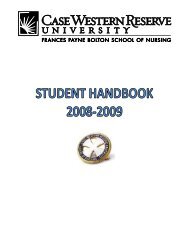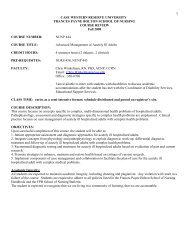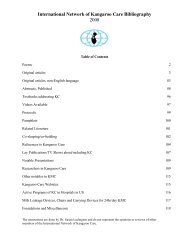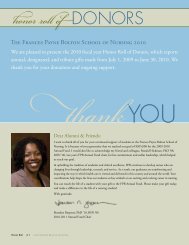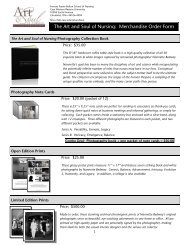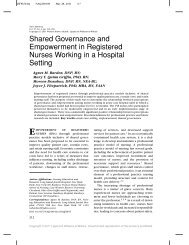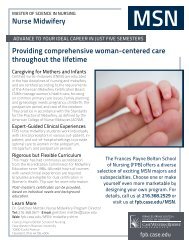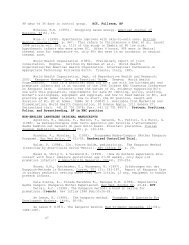Kangaroo Care BIBLIOGRAPHY Develope
Kangaroo Care BIBLIOGRAPHY Develope
Kangaroo Care BIBLIOGRAPHY Develope
You also want an ePaper? Increase the reach of your titles
YUMPU automatically turns print PDFs into web optimized ePapers that Google loves.
Aucott S., Donohue PK, Atkins E., Allen MC. 2002. Neurodevelopmental carein the NICU. Mental Retardation and Developmental Disabilities Research Reviews,8(4), 298-308.On page 304 are 1.33 columns of KC, mostly citing the Conde-Agudelo 2002 Cochrane Review. Says that parent disenfranchisement is biggestNICU problem, and KC corrects this on page 304. There is a whole column devotedto KC history (very brief) and outcomes of the 2002 Conde-Agudelo meta-analysis.ReviewBakewell-Sachs, S., Blackburn, S. 2003. State of the Science:Achievements and challenges across the spectrum of care for preterm infants. JObstet Gynecol Neonatal Nursing, 32 #5, 683-695. On page 688 it states “Manydevelopmental strategies were implemented before undergoing adequate scientifictesting. More research is needed,but the evidence base is growing forinterventions such as cycled lighting, kangaroo care, nonnutritive sucking,containment, touch, and positioning, due in large part to the work of nurseresearchers”.Bowie BH, Hall RB, Faulkner J, Anderson B. 2003. Single-room infant care:future trends in special care nursery planning and design. Neonatal Network 22(4), 27-34. On page 28 it states: “Also in the early 1990s several articleswere published documenting the benefits of skin-to-skin(kangaroo) care, andforthe first time in many nurseries, parents were encouraged to participate in thecare of their preterm infant.” And “Privacy became limited;movable screens wereused to give a sense of privacy for breastfeeding mothers and for parentsproviding <strong>Kangaroo</strong> <strong>Care</strong>.” They have drawing of KC in a single-room on page 31.PT. Not KC study per se.Christensson Bhat et al.. 1995De Chateau. 1979. Effects of Hospital Practices on synchrony in thedevelopment of the infant-parent relationship. Seminars in Perinatology, 3(1),45-60.Drummond T. 1998. Touch early and often. Time July 27, 1998, p. 54-55.Speaks to Dr. Tiffany Fields work with massaging preterm infants and theirimprovement in weight gain.Epstein, R., Herer, P, Tzischinsky, O., & Lavie, P. (1997). Changing fromcommunal to familial sleep arrangement in the Kibbutz Effects on sleep quality.Sleep, 20(5): 334-339. Better quality sleep when they change from communalsleep to sleeping with families.Communal sleep group slept worse than childrenexamined during Golf War. Improvement in sleep quality is due to children'sincreased sense of security when sleeping with their families.Feldman R, Eidelman AI. (1998). Intervention programs for prematureinfants. How do they affect development? Clinics in Perinatology, 25(3): 613-626. This review article states that “<strong>Kangaroo</strong> <strong>Care</strong> is suggested as theintervention that most logically meshes the premature infant’s need to developstate regulation while facilitating sequential sensory development and promotingmother-infant attachment.Field, T.F. (1990) Alleviating stress in newborn infants in intensive careunit. Clinics in Perinatology, 17(1), 1-9.Freda, M.C. 2003. Nursing’s Contribution to the literature on pretermlabor and birth. J Obstet Gynecol Neonatal Nursing, 32(5), 659-667. On page 664she writes “Another intervention for the preterm infant that has been studiedoften by nurses is skin-to-skin care or kangaroo care (KC). It is thought thatthis intervention decreases neonatal energy expenditure and promotes infantgrowth. Ludington-Hoe et al. (1999) found that beginning in the delivery room,KC could be done safely and that infants’ temperatures rose rapidly to the70




